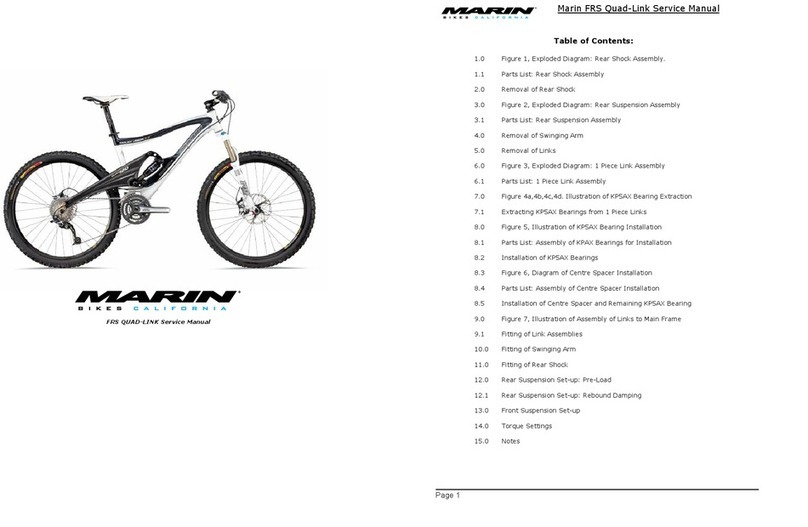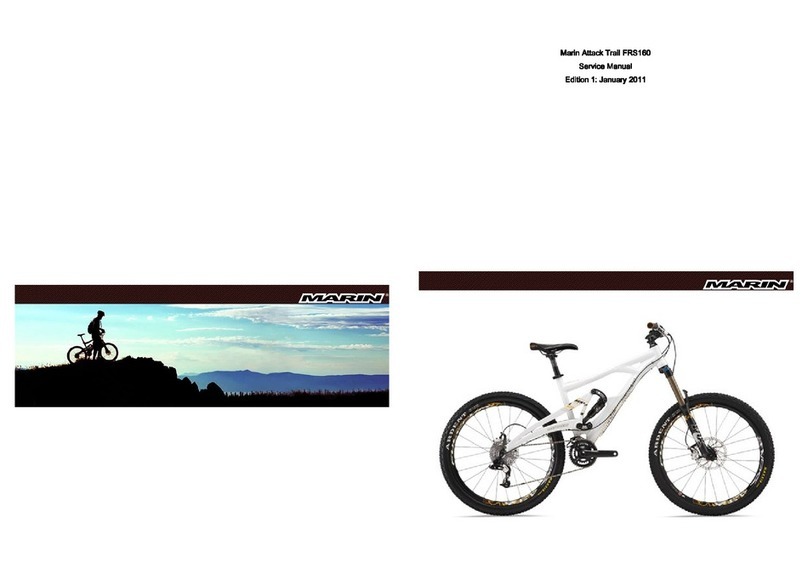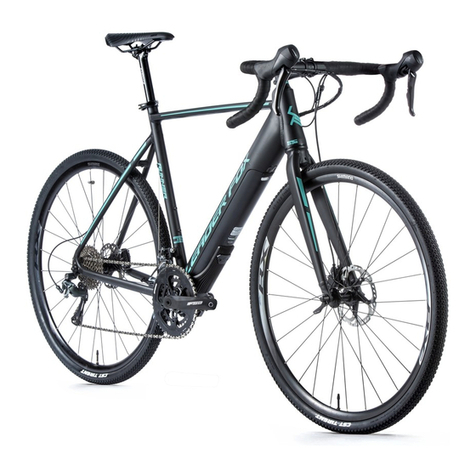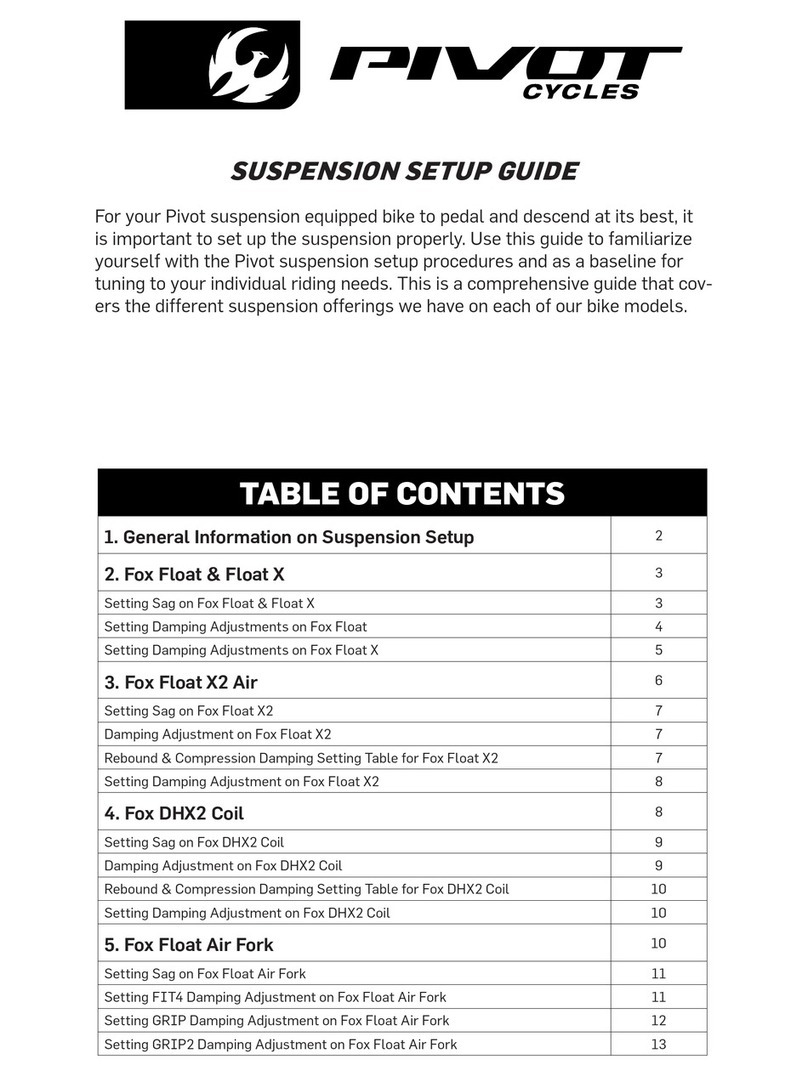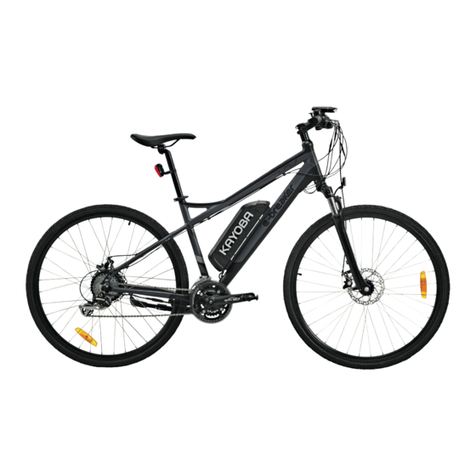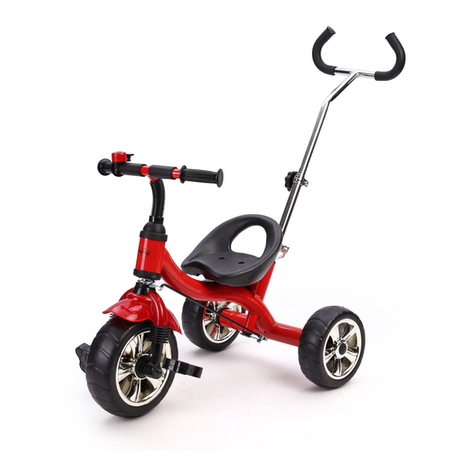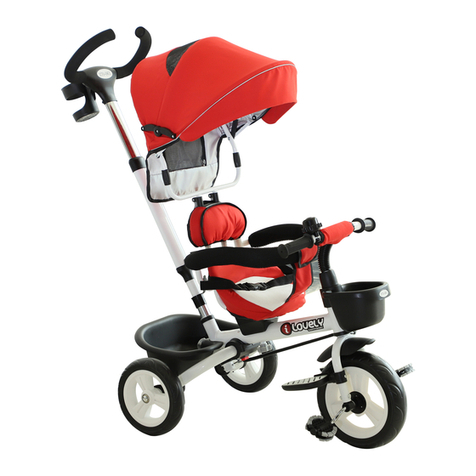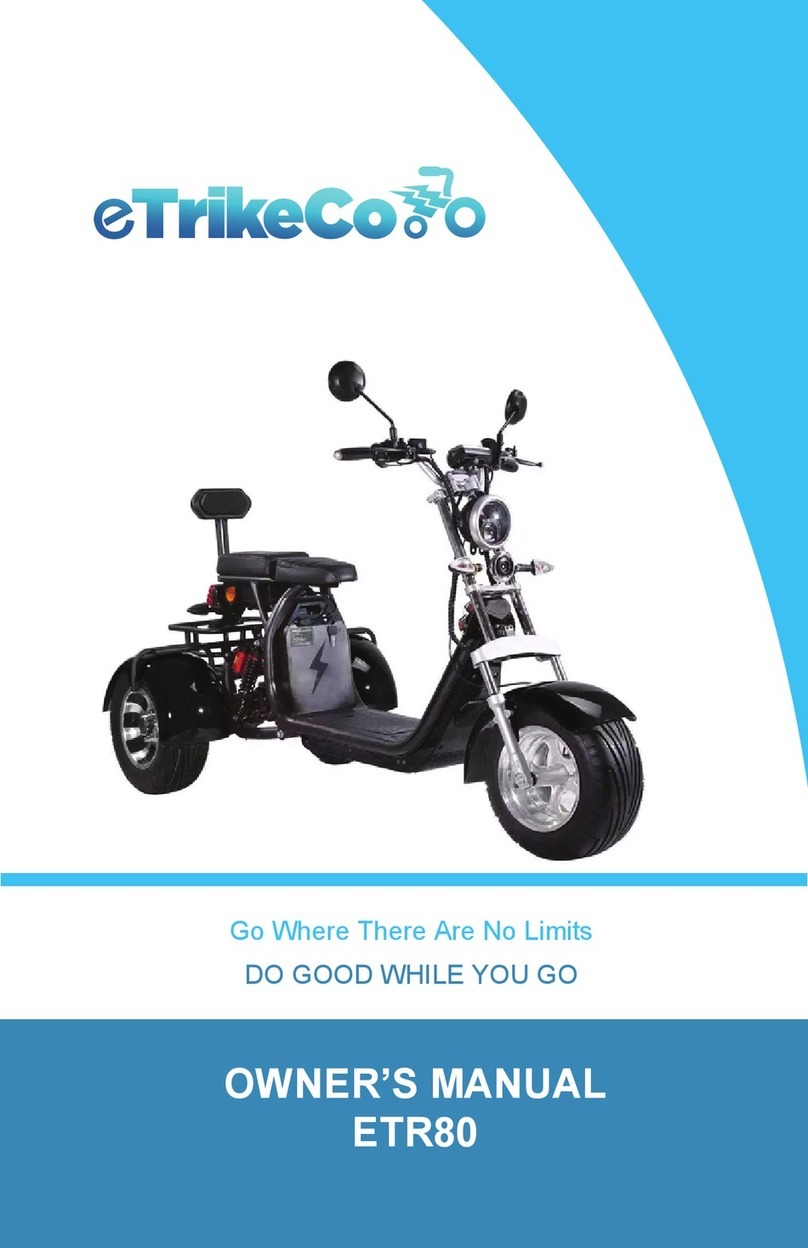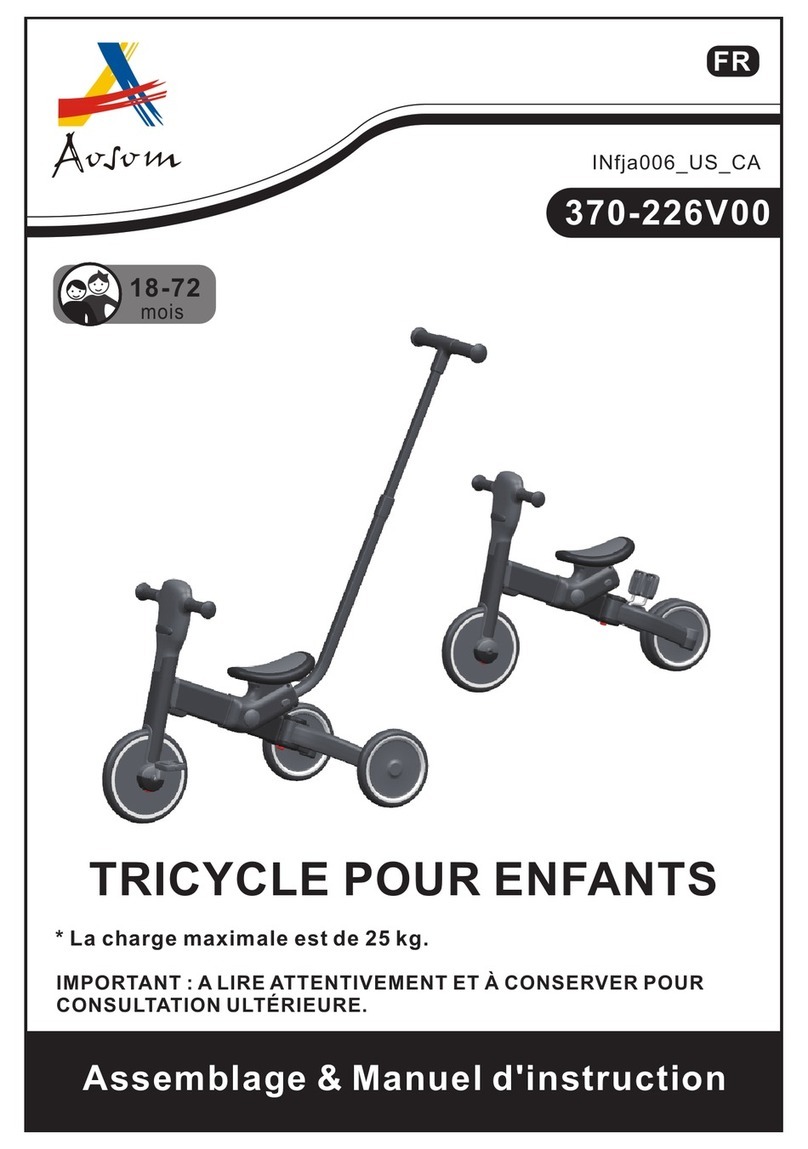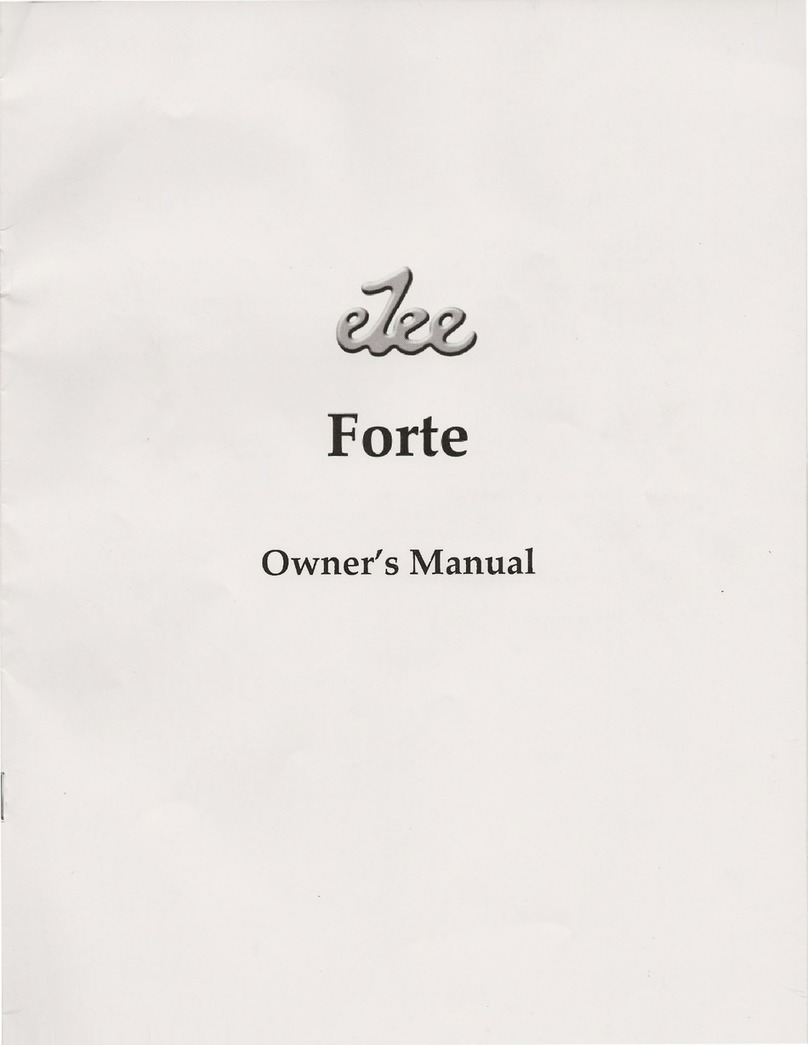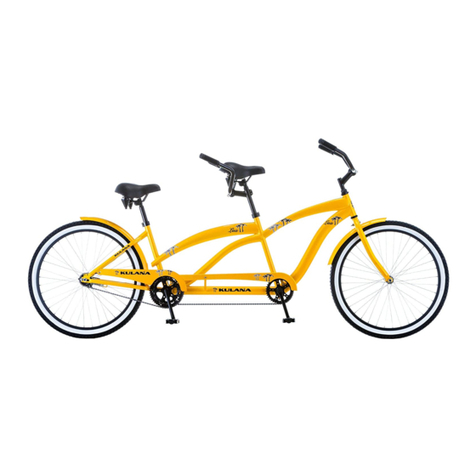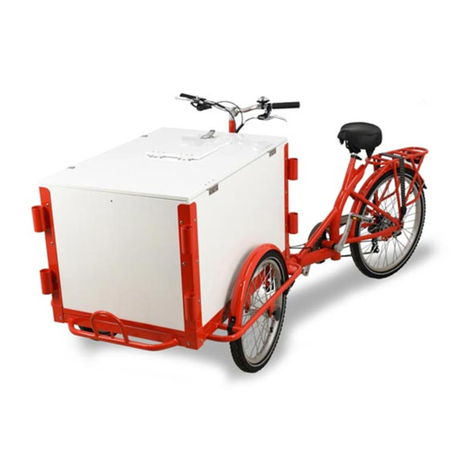MARIN Rift Zon User manual

2011 Marin Rift Zone
2011 Marin Rift Zone2011 Marin Rift Zone
2011 Marin Rift Zone
2011 Marin Mount Vision
2011 Marin Mount Vision2011 Marin Mount Vision
2011 Marin Mount Vision
Service Manual
Service ManualService Manual
Service Manual
Edition 1: January 2011
Edition 1: January 2011Edition 1: January 2011
Edition 1: January 2011

2011 Marin Rift Zone & Mount Vision Service Manual
2011 Marin Rift Zone & Mount Vision Service Manual2011 Marin Rift Zone & Mount Vision Service Manual
2011 Marin Rift Zone & Mount Vision Service Manual
Page 23

2011 Marin Rift Zone & Mount Vision Service Manual
2011 Marin Rift Zone & Mount Vision Service Manual2011 Marin Rift Zone & Mount Vision Service Manual
2011 Marin Rift Zone & Mount Vision Service Manual
Page 22
Table of Contents
1.0 Introduction
2.0 Marin Geometry:
2.1 Rift Zone
2.2 Mount Vision
3.0 Preparations for riding:
3.1 Making ad ustments
3.2 Set up of Fork
3.3 Set up of Rear Shock
4.0 Safety.
5.0 Lubrication:
6.0 Servicing the Rear Suspension:
6.1 Removing the Rear Shock and Swinging Arm
6.2 Stripping and Re-assembling Upper and Lower Quad-Links
6.2.1 Extraction of KP5AX flanged or KP6AX Bearings
6.2.2 Insertion of KP5AX flanged or KP6AX Bearings
6.2.3 Re-Assembly of Quad-Links
6.3 Re-assembling the Rear Suspension
7.0 Servicing The Marin Mount Vision Rear Dropout System
7.1: Removing the Rear Dropouts from the Swinging Arm.
7.2: Assembling the Rear Dropouts onto the Swinging Arm
8.0 Tightening Torque Settings.
9.0 Notes

2011 Marin Rift Zone & Mount Vision Service Manual
2011 Marin Rift Zone & Mount Vision Service Manual2011 Marin Rift Zone & Mount Vision Service Manual
2011 Marin Rift Zone & Mount Vision Service Manual
Page 4
1.0: INTRODUCTION
Thanks for choosing Marin. We hope you will en oy all the benefits its advanced design and
engineering will bring to your riding experience.
This manual will guide you through the set-up, safety and maintenance procedures that
are specific to your Marin suspension frameset. For other more general information, we
strongly advise that you also read thoroughly the General Instruction Manual that is also
supplied with your new bike.
Also, please note that the specification of all the components that are fitted to your bike as
standard may be obtained from the Marin Bikes Brochure or alternatively from the Marin
Bikes website www.marin.co.uk
Bundled with this manual, are the respective manufacturers instructions and manuals for
the branded parts that go to make up the Marin build. Please take time to study both this
manual and all the relevant instruction manuals to ensure you have a continually safe and
well set-up bike before every ride, and to help you build up a relationship of knowledge
between you and your Marin Dealer.
Marin design team. January 2011
2011 Marin Rift Zone & Mount Vision Service Manual
2011 Marin Rift Zone & Mount Vision Service Manual2011 Marin Rift Zone & Mount Vision Service Manual
2011 Marin Rift Zone & Mount Vision Service Manual
Page 21
9.0: NOTE

2011 Marin Rift Zone & Mount Vision Service Manual
2011 Marin Rift Zone & Mount Vision Service Manual2011 Marin Rift Zone & Mount Vision Service Manual
2011 Marin Rift Zone & Mount Vision Service Manual
Page 20
7.1: Removing the Rear Dropouts from the winging Arm.
Tools Required: 5mm Allen Key
6mm Allen Key
Both Left (4) and Right Hand (2) dropouts are a modular design, that can be replaced if
damaged. They are each attached to the Swinging Arm (3) by two bolts (1a & 1b), see fig.
8. To remove either Right Hand (2) or Left Hand (4) dropout using the 5mm Allen key for
the outside bolts (1a) and 6mm Allen key for the Inside Bolts (1b), undo both bolts, and
remove them from the assembly. The Dropout (2 & 4) should now be detached from the
Swinging Arm (3). Take care not to loose any of the components.
7.2: Assembling the Rear Dropouts onto the winging Arm
Tools Required: 5mm Allen Key
6mm Allen Key
Torque Wrenc
Loctitie 638 retaining compound
It is important to make sure the Swinging Arm (3) and Dropouts (2 & 4) are clean and free
from mud and other dirt, which could prevent the Dropouts (2 & 4) and Swinging Arm (3)
from fitting together perfectly. Before assembling the bolts (1a & 1b), apply a small
amount of Loctite 638 retaining compound to the threads of each of the bolts (1a & 1b).
Next, assemble the parts as shown in Fig 8. making sure the Bolts (1a & 1b) are correctly
positioned as shown. Using the Torque Wrench, tighten the bolts (1a & 1b) to the correct
torque as specified in Section 8.0.
8.0: TORQUE ETTING
Torque explained: If no suitable Torque Wrenc is available a Torque of 5 lbf.ft can be obtained by ap-
plying a force of 5lb, wit a Spring Balance, to t e end of a spanner, 1 Foot in lengt .
IMPORTANT: For all other torque settings, refer to the specific manufacturers information
bundled with this manual, or alternatively, refer to the specific manufacturers website for
further information.
Quad-Link 2 uspension: Nm lbs.ft
M8 AeroSpace Nuts 18.0 +/- 2.0 13.3 +/- 1.5
Bearing Caps 5.0 +/- 0.5 3.7 +/- 0.4
Rear Dropout Assembly
Bolts 13.0 +/- 1.5 9.6 +/- 1.0
M5 Countersunk Capscrews 14 +/- 1.4 10.3 +/- 1.0
2011 Marin Rift Zone & Mount Vision Service Manual
2011 Marin Rift Zone & Mount Vision Service Manual2011 Marin Rift Zone & Mount Vision Service Manual
2011 Marin Rift Zone & Mount Vision Service Manual
Page 5
2.0: GEOMETRY
2.1: RIFT ZONE
Note: This is ‘Showroom’ Geometry, ie: without a rider sat on the bicycle.
*Top tube length is the distance from the point where the centre line of the head tube meets the centre line of the top
tube, horizontally back to the centre line of the seat tube.
**BB Height will vary, depending on what tyre size is actually fitted.
FRAME SIZE XS 15.0” S 16.0” M 17.5” L 19” XL 20.5”
Head Tube Angle (A) 69° 69° 69° 69° 69°
Seat Tube Angle (B) 72.7° 72.9° 73° 73.1° 73.4°
Top Tube* (C) 567.6mm / 22.3” 587.5mm / 23.1” 605mm / 23.8” 616mm / 24.3” 625.4mm / 24.6”
BB Height** (D) 329mm / 12.95” 328mm / 12.9” 327mm / 12.9” 326mm / 12.8” 324mm / 12.75”
Stand Over (E) 754mm / 29.7" 773mm / 30.4" 795mm / 31.3" 821mm / 32.3" 844mm / 33.2"
Wheel Base (F) 1069mm / 42.0" 1091mm / 42.95" 1110mm / 43.7" 1123mm / 44.0" 1130mm / 44.2"
Head Tube (G) 107.0mm / 4.2” 120.0mm / 4.7” 130.0mm / 5.1” 142.0mm / 5.6” 155.0mm / 6.1”
Seat Post Ø (H) 27.2mm / 1.07" 27.2mm / 1.07" 27.2mm / 1.07" 27.2mm / 1.07" 27.2mm / 1.07"
Seat Tube (I) 381.0mm / 15.0” 406.4mm / 16.0” 444.5mm / 17.5” 482.6mm / 19” 520.7mm / 20.5”
Fig.1: Geometry

2011 Marin Rift Zone & Mount Vision Service Manual
2011 Marin Rift Zone & Mount Vision Service Manual2011 Marin Rift Zone & Mount Vision Service Manual
2011 Marin Rift Zone & Mount Vision Service Manual
Page 6
2.2: MOUNT VI ION
3.0: PREPARATION FOR RIDING
3.1: MAKING ADJU TMENT :
Please refer to the specific component manufacturers
manual or published technical information about
ad usting the components on your Marin. Instruc-
tions may be downloaded from the relevant manu-
facturer’s internet site, as shown in the table to the
right.
If you are uncertain in any way, about making ad-
ustments to any components on you Marin, then DO
NOT RIDE YOUR BIKE. Contact your Marin dealer
who will be able to advise you on how to go about
setting up you Marin for riding, and or making ad-
ustments to the components fitted to your Marin.
3.2: ET UP OF FORK
Tools Required: Good Quality S ock Pump.
Please note that for the detailed instructions for servicing and all matters relating to the
fork, please refer to the manufacturers instructions accompanying this manual.
FRAME SIZE XS 15.5” S 16.5” M 17.5” L 19”
Head Tube Angle (A) 67.5° 67.5° 67.5° 67.5°
Seat Tube Angle (B) 72.6° 73.1° 73.5° 73.6°
Top Tube* (C) 561.4mm / 22.1” 577mm / 22.7” 595mm / 23.4” 606.1mm / 23.9”
BB Height** (D) 333mm / 13.1” 337mm / 12.3” 340mm / 13.4” 341mm / 13.4”
Stand Over (E) 773mm / 30.4" 792mm / 31.3" 820mm / 32.3" 836mm / 32.9"
Wheel Base (F) 1091mm / 42.95" 1111mm / 43.7" 1133mm / 44.6" 1145mm / 45.1"
Head Tube (G) 107.0mm / 4.2” 115.0mm / 4.5” 120.0mm / 4.7” 125.0mm / 4.9”
Seat Post Ø (H) 30.9mm / 1.217" 30.9mm / 1.217" 30.9mm / 1.217" 30.9mm / 1.217"
Seat Tube (I) 393.0mm / 15.5” 419.1mm / 16.5” 444.5mm / 17.5” 482.6mm / 19”
Note: This is ‘Showroom’ Geometry, ie: without a rider sat on the bicycle.
*Top tube length is the distance from the point where the centre line of the head tube meets the centre line of the top
tube, horizontally back to the centre line of the seat tube.
**BB Height will vary, depending on what tyre size is actually fitted.
Continental www.conti-tyres.co.uk
Easton www.eastonbike.com
FSA www.fullspeedahead.com
Fox www.foxracingshox.com
Formula www.formulahubs.com
Hayes www.hayesdiscbrake.com
Marzocchi www.marzocchi.com
Mavic www.mavic.com
Maxxis www.maxxis.com
Shimano www.shimano.com
SRAM www.sram.com
Sun Ringle www.sun-ringle.com
WTB www.wtb.com
2011 Marin Rift Zone & Mount Vision Service Manual
2011 Marin Rift Zone & Mount Vision Service Manual2011 Marin Rift Zone & Mount Vision Service Manual
2011 Marin Rift Zone & Mount Vision Service Manual
Page 19
7.0: ERVICING THE MARIN MOUNT VI ION DROPOUT Y TEM.
Item Description
1a Chain ring Bolt Male
1b Chain Ring Bolt Female
2 Dropout, Q/R Modular Type, Derailleur side
3 Swinging Arm Mounting Point
4 Dropout, Q/R Modular Type, Disc side
Fig.8: Exploded view of Dropout Assembly
Bearing Caps (1). Using the large flat blade screwdriver, tighten the Bearing Caps (1) to
stop them from shaking loose. (Refer to the Tightening torque settings in Section 8.0).
Finally, refit the rear wheel into the swinging arm.

2011 Marin Rift Zone & Mount Vision Service Manual
2011 Marin Rift Zone & Mount Vision Service Manual2011 Marin Rift Zone & Mount Vision Service Manual
2011 Marin Rift Zone & Mount Vision Service Manual
Page 18
6.3.2: REA EMBLING THE REAR U PEN ION
(For pictorial views of the assembly, refer to Fig. 2 on page 11)
Tools Required: Large Flat Blade Screwdriver
10mm A/F Spanner
Torque Wrenc wit 10mm A/F socket
The re-assembly of the rear suspension is basically the reverse of the disassembly proce-
dure in section 6.1. Starting with the shorter lower Quad Link (5), ensure that the link is
complete and correctly assembled (See Fig.4). Next make sure the lower Quad-Link (5) is
correctly orientated (see fig. 6) and pass a 90mm long M8 stud (8) through the lower
Quad-Link (5) and front triangle (6). Next take the rear shock (7) and assemble the upper
mount of the rear shock (7) using SKF LG/AF anti fret paste on the contacting surfaces,
into the upper shock mount of the Mainframe (6). IMPORTANT. Ensure the rear shock is
the correct way up, with the blue Pro Pedal lever facing forwards. Assemble the longer up-
per Quad-Link (4) onto the Mainframe (6), and pass a 78mm long M8 stud (9) through the
upper Quad-Link (4), the Mainframe (6) and through the front of the rear shock (7) until
the 78mm long M8 stud (9) is showing out the other side of the upper Quad-Link(4). You
should now have both upper and lower Quad-Links assembled onto the Mainframe (6), with
the rear shock (7) in position. Next lower the Swinging Arm (3) onto the rear suspension
assembly and position the Swinging Arm (3) onto the upper Quad-Link (4) first. Make sure
that the Inner Shield Washers (1, Fig.3) are present. Pass the Hollow Pin (13) into the up-
per Quad-Link (4) and Swinging Arm (3). Place washers (12) each side of the swinging arm
(3), making sure the flat side of the washer faces the swinging arm. Screw in both M5
countersunk capscrews (11) into either side of the hollow pin (13). Tighten both capscrews
(11) to the recommended setting. (Refer to the Tightening torque settings in Section 8.0).
Next rotate the Swinging Arm (3) down to attach it to the lower Quad-Link (5) and the rear
shock (7). Once you have the Swinging Arm (3) in the correct position, make sure that the
lower Quad-Link (5), the Swinging Arm (3) and the Rear shock (7) though holes are all
concentric with each other, and push through the last remaining 90mm long M8 stud (10).
Next re-fit the M8 Aerospace Nuts (3). IMPORTANT: before final tightening of the M8 Aero-
space Nuts (3), it is important to make sure that there is a balanced amount of thread
showing through the M8 Aero-
space Nuts (2) on each side of
the upper and lower Quad-Link
assemblies, see fig. 7. Using the
small slotted screwdriver in the
end of the M8 studs (8, 9 & 10),
and the 10mm spanner, ad ust
all 4 M8 Shafts (8, 9 & 10) ac-
cordingly. Refer to Fig. 9. Tighten
all M8 Aerospace Nuts (2) to the
recommended settings. (Refer to
the Tightening torque settings in
Section 8.0) Next make sure that
there is still a substantial amount
of Molykote 111 Silicon covering
all the KP5AX Bearings. Refit the
Bearing Caps (1) by screwing
them clockwise into the links.
Take care not to cross thread the
Fig.7: Maximum Thread Protrusion
2011 Marin Rift Zone & Mount Vision Service Manual
2011 Marin Rift Zone & Mount Vision Service Manual2011 Marin Rift Zone & Mount Vision Service Manual
2011 Marin Rift Zone & Mount Vision Service Manual
Page 7
The front fork is pre-set with standard settings when you buy your Marin. Before rid-
ing, you will need to ad ust the sag setting on the fork. This is to ensure it is set-up
correctly for your own body weight, so the fork will perform as intended.
To set sag on a front fork, you need to measure the amount the fork compresses
when you sit on the bike in the normal riding position. We recommend for the best
synergy between front and rear suspension systems to run approximately 16mm
(16%) sag on the Rift Zone front fork and approximately 23mm (16%) sag on the
Mount Vision front fork.
Sag on forks is controlled by ad usting the Air Spring pressure, or if you have a coil
spring fork, the rate of the coil spring inside the fork. This is not ad ustable, and re-
quires the fork to be rebuilt with a different spring. Please consult your Marin Dealer
for more information.
Rebound Damping ad ustment:
This ad ustment fine-tunes the speed at which the wheel returns to its normal ride
height after hitting a bump. To demonstrate the effect of this function, turn the
ad uster to its slowest setting. Press down on the handlebars to compress the forks,
then release the load. The suspension recovers very slowly to its original position.
Repeat the above with the ad uster turned to the fastest setting and the difference
will be seen immediately the load is released. We recommend the optimum setting is
to ad ust the re-bound damping to be as slow as possible, but not so slow that the
normal ride height is not recovered. On very rough terrain, if the front or rear of the
bike becomes progressively lower as more bumps are hit then the re-bound damping
is set too slow. On the other hand if the bike feels choppy and not plush then the re-
bound damping is too fast. A bit of trial and error is needed to get the exact setting.
Riders may choose to change their settings, while stationary, depending on the terrain
they are riding.
3.3: ET UP OF REAR HOCK
Tools Required: Good Quality S ock Pump.
Please note that for the detailed instructions for servicing and all matters relating to
the rear shock, please refer to the manufacturers instructions accompanying this
manual.
The rear shock is pre-set with standard settings when you buy your Marin. Before
riding, you will need to fine ad ust the sag setting on the rear shock. This is to ensure
it is set-up correctly for your own body weight, so the shock will perform as intended.
The correct ‘sag’ can be found using the sliding ‘o’ ring fitted to the shaft of the shock
piston. Slide the ‘o’ ring against the shock body. Then gently sit on the bike in your
normal riding position. Carefully dismount and measure the distance the ‘o’ ring has
moved away from the shock body. The optimum distance for the Marin QUAD 2 sys-
tem is between 25% and 30% displacement from the ‘o’ ring back up to the shock

2011 Marin Rift Zone & Mount Vision Service Manual
2011 Marin Rift Zone & Mount Vision Service Manual2011 Marin Rift Zone & Mount Vision Service Manual
2011 Marin Rift Zone & Mount Vision Service Manual
Page 8
body. 25% sag gives a firmer ride, and 30% sag gives a plusher ride. Trial and error is
required to arrive at a setting which you are happy with. For the Rift Zone rear shock, 25%
sag is 9.5mm and 30% sag is 11.4mm. For the Mount Vision rear shock, 25% sag is
14.3mm and 30% sag is 17.1mm.
If there is less sag than required, fit a shock pump and release air pressure. Conversely if
there is greater sag than required, fit the shock pump and increase air pressure. Repeat
the ‘sag’ test until the desired displacement is achieved.
Rear Suspension Set-up - Rebound Damping:
When the rear shock is being compressed, this is known as the compression stroke. As the
suspension unit recovers from compression back towards its full length, this is called the
re-bound stroke. All the shocks fitted as standard to Marin full suspension bikes have fac-
tory set compression damping, and manually ad ustable rebound damping.
Rebound Damping Ad ustment:
This ad ustment fine-tunes the speed at which the rear wheel returns to its normal ride
height after hitting a bump. The ad uster is coloured red and is found on the rear shock. An
arrow marked slower indicates the direction to turn the dial to slow down the re-bound
speed of the suspension. To demonstrate the effect of this, turn the ad uster to its slowest
setting. Press down on the saddle to compress the suspension, then release the load. The
suspension recovers very slowly to its original position.
Repeat the above with the ad uster turned to the fastest setting and the difference will be
seen immediately the load is released. We recommend the optimum setting is to ad ust the
re-bound damping to be as slow as possible, but not so slow that the normal ride height is
not recovered. On very rough terrain, if the rear of the bike becomes progressively lower
as more bumps are hit then the re-bound damping is set too slow. On the other hand if the
bike feels choppy and not plush then the re-bound damping is too fast. A bit of trial and
error is needed to get the exact setting.
IMPORTANT AFETY NOTE: Always stop riding when making ad ustments of any kind to
the bicycle!
Rear Shock Ad ustment.
Please refer to the relevant Instruction Manual to learn more about the advanced features
of your rear shock.
4.0: AFETY
IMPORTANT: The following are intended to be advisory notes on the safe use of your
Marin. If at any stage you are uncertain about the safety or safe operation of the bike as a
whole, or any specific component, then DO NOT RIDE YOUR Marin and instead please
consult the specific component manufacturers instruction manual or your Marin Dealer for
advice.
2011 Marin Rift Zone & Mount Vision Service Manual
2011 Marin Rift Zone & Mount Vision Service Manual2011 Marin Rift Zone & Mount Vision Service Manual
2011 Marin Rift Zone & Mount Vision Service Manual
Page 17
6.3: REA EMBLING THE REAR U PEN ION.
6.3.1: CORRECT ORIENTATION OF QUAD-LINK .
Note that both links can be assembled either way up. They MUST be orientated as shown
in fig. 6, otherwise they will touch the rear shock.
Fig.6: Quad-Link Orientation

2011 Marin Rift Zone & Mount Vision Service Manual
2011 Marin Rift Zone & Mount Vision Service Manual2011 Marin Rift Zone & Mount Vision Service Manual
2011 Marin Rift Zone & Mount Vision Service Manual
Page 16
6.2.2: IN ERTION OF KP5AX & KP6AX BEARING
Tools required: KP5AX & KP6AX bearing press tools.
6mm AF Allen Key
10mm AF Ring Spanner
De-greasing fluid, eg: “Muc-off”
Loctite 638 Ad esive
Before re-assembling both upper and lower link assemblies, make sure all the components
are clean from dirt and have been thoroughly de-greased. To press the KP5AX flanged
bearings (5) into the Link Body (4) apply a small amount of Loctite 638 to the outside di-
ameter of the KP5AX flanged bearing and to the inside bearing bore of the Link Body (4).
Next assembly the components as illustrated in Fig.5b, noting how the bearing’s
flanged side must face towards the middle of the link. Aslo, it is very important to
make sure the KP5AX (5) bearing and Bearing Insertion tool 1 (3) are squarely seated
against the Link Body (4). With great care, slowly tighten the M8 Socket head cap screw
(7) with the 6mm Allen key and 10mm Spanner until you can see the KP5AX flanged bear-
ing (5) being pressed squarely into the Link Body (4). Once the KP5AX flanged bearing is
fully seated and you can no longer tighten the M8 Socket Head Cap Screw further, undo
the nut and bolt and wipe away any excess Loctite from around the KP5AX flanged bearing.
Repeat for the remaining 5 KP5AX flanged bearings. Finally, check that the bearings are
aligned with each other by inserting an M8 Shaft through each pair of bearings at each
ends of the link. The shaft must pass through freely. If not, then the bearings are not
sitting squarely in the links. Use the Bearing Insertion tool 1 (3) again to square them up
and confirm that by inserting the M8 Shaft again.
For insertion of the KP6AX bearing, repeat the same procedure as above, except use the
KP6AX insertion tool. Also, check for correct alignment of the KP6AX bearing when re-
assembling the spacers and swinging arm as described below. Poor alignment would re-
sult in the parts not being able to easily slide between each other.
6.2.3: REA EMBLY OF QUAD-LINK
Tools required: Molykote Silicon 111 Grease
Before re-assembling the shield washers into the upper link (1 in fig. 3), apply a good
quantity of Molykote 111 Silicon on top of the KP6AX Bearing (2 in fig.3). The Molykote
Silicon should completely cover the bearing and be applied on both sides of the bearing as
the washer is assembled into the Link Body (4 in fig. 3). If you have applied enough Mo-
lykote 111 Silicon, it should spread from under the Shield Washer component as they are
positioned, so as to protect the bearing from contamination. Wipe this excess Silicon away
from around the Shield Washer Components.
APPLICATION OF KF LG/AF or Castrol Optimol T ANTI-FRET PA TE
Once the Links have been assembled correctly, KF LGAF 3 Compound or Castrol
Optimol T must be applied to all outside faces of the bearing flanges, that contact
the Main Frame and winging Arm. It is additionally recommended to apply KF
LGAF 3 compound Castrol Optimol T to the link contact surfaces on the Main
Frame and winging Arm.
Loctite 638 & SKF LGAF3 can be purchased from Brammer Ltd www.brammer.co.uk
Castrol Optimol T can be purchased from Motobins www.motobins.co.uk
Molycote 111 can be purchased from Sil-Mid Ltd www.silmid.com
2011 Marin Rift Zone & Mount Vision Service Manual
2011 Marin Rift Zone & Mount Vision Service Manual2011 Marin Rift Zone & Mount Vision Service Manual
2011 Marin Rift Zone & Mount Vision Service Manual
Page 9
WARNING: As is the case with all mechanical components, the bicycle is sub ected to
wear and high stresses. Different materials and components may react to wear and stress
fatigue in different ways. If the design life of a component has been exceeded, it may fail
suddenly causing possible in ury to the rider. Any form of crack, scratches and decolouring
in highly stresses areas are showing that the component has exhausted its life time and
has to be replaced. If you are in any doubt about the condition of any of the components
on your Marin DO NOT RIDE YOUR BIKE. Consult the specific component manufacturers
literature, or take your bike to your local Marin Dealer for advise.
Before your first ride:
• Brake levers: Familiarise yourself with which brake lever operates which brake. As
standard the Marin is set-up so as the right-hand brake lever operates the front
brake, and the left hand brake lever operates the rear brake.
• Gear hifters: Familiarise yourself with the function and operation of the gear shift
levers in accordance with the manufacturers instruction and guidance
• Marin Lock On Grips: Make sure the grips are securely fastened to the handlebars
and cannot rotate or become loose at any time during riding.
• Tyre pressures: They should be set by your dealer before you collect the bike.
However, ensure that the tyre pressures are between the upper and lower limits as
shown on the sidewalls of the tyres.
• uspension ettings: Ensure that you have followed the recommended proce-
dures for setting up the Marin suspension systems outlined in Sections 3.2 and 3.3
of this manual. Also refer to the relevant instructions and guidance as outlined in
the Front Fork and Rear Damper manuals.
• IMPORTANT: please note that you must ensure that your Marin complies with your
countries National Legal Requirements when the bicycle is used on public roads.
After Every Ride:
• Post-Ride cleaning: We strongly recommend cleaning your bike after every ride.
This provides you with the best opportunity of a close and systematic inspection of
almost every component, for damage and wear on a ride by ride basis.
Lubrication: Directly after cleaning your bike after a ride, is the best time to carry out the
lubrication regime for the various components as outlined in this manual, and in the re-
spective component manufactures technical information.
Before every ride: Pre-ride safety check.
• Frameset Components: We recommend that before every ride you visually in-
spect the mainframe swinging arm and associated components for signs of damage
or excessive wear due to hard use.
• Brakes: Check the Disc and Brake pads for wear and performance degradation, and
the hydraulic hoses for damage, in accordance with the specific recommendations in
the relevant component makers instruction manual bundled with this manual.
• Wheels: Check that both wheels are securely attached to the bike, and the respec-

2011 Marin Rift Zone & Mount Vision Service Manual
2011 Marin Rift Zone & Mount Vision Service Manual2011 Marin Rift Zone & Mount Vision Service Manual
2011 Marin Rift Zone & Mount Vision Service Manual
Page 10
tive dropout systems are correctly ad usted. Check the condition of both wheels,
and look for cracks or large dents in the aluminium Rim, and check for loose or bro-
ken spokes and/or spoke nipples, and wheels out of alignment in line with the spe-
cific recommendations in the relevant instruction manual bundled with this manual.
• Lubrication: Check all parts have been lubricated in accordance with the specific
component makers instruction manual.
• Gear hifting: Check for and replace any frayed or degraded cable inner wire and
outer casing and check all relevant parts are in correct ad ustment for use in accor-
dance with the specific instruction manual
• teering and Headset: Check for loose headset bearings or tight spots when turn-
ing the handlebars in both directions, and service, ad ust or replace in accordance
with the manufacturers specific instruction manual.
• Tyres: Check for excessively worn, or cut tyres. Check the inflation pressure is
within the recommended range. Refer to the specific manufacturers recommenda-
tions.
• uspension ettings: Ensure that you have followed the recommended proce-
dures for setting up the Marin suspension systems outlined in Sections 3.2 and 3.3
of this manual. Also refer to the relevant instructions and guidance as outlined in
the Front Fork and Rear Damper manuals.
• Helmet: We recommend that for off-Road riding, a helmet meeting a reputable
international standard is used and be worn on every ride. Check the helmet is not
damaged in any way before riding. Do not ride if your helmet has sustained dam-
age.
Designed for the following use:
The Marin Rift Zone and Mount Vision bikes have been designed, tested and comply with
BS EN 14766 Safety Standard, for typical Cross Country Mountain Biking use. They have
not been designed or tested for extreme down-hilling or aggressive Free-Riding.
5.0: LUBRICATION
For the correct lubrication regime and maintenance of all parts on all models of Marin
bikes, please refer to the specific component manufacturers detailed instructions bundled
with this manual or for further information visit the specific manufacturers website. Any
lubrication requirements regarding the Marin Quad-Link suspension system are covered in
the disassembly and re-assembly sections in this manual. If you are in any doubt, please
contact your local Marin Dealer.
2011 Marin Rift Zone & Mount Vision Service Manual
2011 Marin Rift Zone & Mount Vision Service Manual2011 Marin Rift Zone & Mount Vision Service Manual
2011 Marin Rift Zone & Mount Vision Service Manual
Page 15
Item: Description.
1 M8 Nut
2 M8 Washer
3 KP5AX or KP6AX Tool 1
4 Link Body
5 KP5AX or KP6AX Bearing
6 KP5AX or KP6AX Tool 2
7 M8x50mm Socket Head Cap Screw
Fig.5a: Bearing Extraction Fig.5b: Bearing Insertion

2011 Marin Rift Zone & Mount Vision Service Manual
2011 Marin Rift Zone & Mount Vision Service Manual2011 Marin Rift Zone & Mount Vision Service Manual
2011 Marin Rift Zone & Mount Vision Service Manual
Page 14
Fig.4: Assembly for lower Quad-Link
Item Description
1 KP5AX flanged bearing
2 Lower Link Body
6.2.1: EXTRACTION OF KP5AX & KP6AX BEARING
Tools required: KP5AX & KP6AX bearing press tools.
6mm AF Allen Key
10mm AF Ring Spanner.
To remove six of the KP5AX flanged bearings from the Link Bodies (2 in fig. 3 & 1 in
fig. 4). Assemble the parts as shown in Fig 5a with the KP5AX bearing press tool. Us-
ing the 6mm Allen Key and 10mm spanner, tighten the assembly together until the
KP5AX bearing (5) is pressed out of the Link Body (4). Repeat this on 5 other KP5AX
bearings.
To remove the KP6AX Bearing (2 in fig. 3). Remove the spacers (1) from both sides of
the bearing. Assemble the parts as shown in Fig 5a with the KP6AX bearing press tool.
Using the 6mm Allen Key and 10mm spanner, tighten the assembly together until the
KP6AX bearing (5) is pressed out of the Link Body (4).
2011 Marin Rift Zone & Mount Vision Service Manual
2011 Marin Rift Zone & Mount Vision Service Manual2011 Marin Rift Zone & Mount Vision Service Manual
2011 Marin Rift Zone & Mount Vision Service Manual
Page 11
6.0: ERVICING THE REAR U PEN ION
Fig.2: Marin Rear uspension

2011 Marin Rift Zone & Mount Vision Service Manual
2011 Marin Rift Zone & Mount Vision Service Manual2011 Marin Rift Zone & Mount Vision Service Manual
2011 Marin Rift Zone & Mount Vision Service Manual
Page 12
Item Description
1 Link Cap Cover
2 M8 Aerospace Nut
3 Rear Swinging Arm
4 Upper Link Assembly
5 Lower Link Assembly
6 Front Triangle
7 Rear Shock
8 M8 x 90mm long Stud
9 M8 x 78mm long Stud
10 M8 x 100mm long Stud
11 M6 x 12mm long Countersunk Screw
12 Washer
13 Hollow Pin
6.1: REMOVING THE REAR HOCK AND WINGING ARM
ee Figure 2
Tools Required: Large Flat Bladed Screwdriver.
10mm A/F Socket Wrenc (2 off) or Ring Spanner (2 off)
Two 4mm A/F Allen Key
To remove the rear shock from the frame, first remove the rear wheel from the swinging
arm. Using the large flat bladed screwdriver, unscrew anticlockwise the 6 Bearing Caps (1).
Take care not to damage the surrounding paint. Next using the 10mm Sockets, undo the
M8 Aerospace nuts (2) on the M8 shaft (10) that pass through the lower link assembly (5)
and swinging arm (3). Whichever Aerospace Nut (3) becomes undone first, remove it, and
pull the M8 Shaft (10) out from the other side. The swinging arm (3) can now be rotated
out of the lower link assembly (5). Next using the two 4mm AF Allen Keys, simultaneously
undo the two M6 x 12 long countersunk screws (11). Remove these, the hollow pin (13)
and the washers (12). You can now lift off the Swinging Arm (3) from the upper (4) and
lower (5) link assemblies—take care not to lose the two washers inserted in the upper link
assembly, reference fig 4. To remove the links from the main frame (6) using the 10mm
Sockets, undo the M8 Aerospace nuts (2) on the M8 shaft (9) that passes through the Main
Frame (6) and top of the shock assembly (7). Again whichever Aerospace Nut (2) becomes
undone first, remove it, and pull the M8 Shaft (9) out from the other side. You can now
remove the shock assembly (7) and Upper Link Assembly (4) from the main frame (6). To
Remove the Lower Link Assembly (5) from the bike, using the 10mm Sockets, undo the M8
Aerospace nuts (2) on the M8 shaft (8) that passes through the Lower Link Assembly (5)
2011 Marin Rift Zone & Mount Vision Service Manual
2011 Marin Rift Zone & Mount Vision Service Manual2011 Marin Rift Zone & Mount Vision Service Manual
2011 Marin Rift Zone & Mount Vision Service Manual
Page 13
and the Main Frame (6) and remove the M8 shaft (8) and the Lower Link Assembly (5)
from the Main Frame (6).
6.2: TRIPPING AND REA EMBLING UPPER AND LOWER QUAD-LINK .
Fig.3: Assembly for upper Quad-Link
Item Description
1 Shield washer
2 KP6AX bearing
3 KP5AX flanged bearing
4 Upper Link Body
This manual suits for next models
3
Table of contents
Other MARIN Bicycle manuals


